 In in-vivo systems, the cells have mechanical support in extracellular vicinity that not only provides overall stability but also facilitates cell-cell interaction, adhesion, cell proliferation, migration and differentiation. This mechanical support is a complex functional bioactive scaffold called the Extracellular matrix (ECM).
In in-vivo systems, the cells have mechanical support in extracellular vicinity that not only provides overall stability but also facilitates cell-cell interaction, adhesion, cell proliferation, migration and differentiation. This mechanical support is a complex functional bioactive scaffold called the Extracellular matrix (ECM).
Structurally, the foundation of ECM is laid by a connectivity of complex fibrous proteins including Collagen, fibronectin and laminin. These proteins are agile and have greater tensile strength allowing the cells to be held in a 3-dimensional structure. Apart from these, the interstitial spaces between this backbone, is filled specialized hydrated proteogylcans. ECMs are dynamic and keep on getting remodelled for migration and proliferation of the cells.
Since the in-vivo system has few limitations in managing functional assays and addressing questions at the level of single cell or molecule, hence the cells are cultured in a dish (in-vitro) in order to have a controlled environment. Mammalian cell culture in in-vitro condition allows a greater degree of manipulation and a well-defined stage for understanding cellular physiology and develops mechanistic insights.
The conventional way was to culture single suspension on a two-dimensional surface such as glass or polystyrene. Although, further experimentation inferred that growing on such hard surfaces create abnormal tensile strength during cell growth which skews morphology, polarity and shape of the cells to a certain aspect. Studies also proved that cells grown directly on promotes atypical cell proliferation and reduce differentiation. This type of culture condition also negates the contribution of extracellular matrix which was shown to be crucial for cellular development. In order to improve this pitfall, a new culture system was brought into substance by using natural or synthetic polymers to use as matrix and allow the cells to grow on it which mimics the interaction of ECM and the surrounding cells. This type of culture is referred as physiological 2-dimensional culture or 2.5-dimensional culture system.
There are two types of matrices that can be used for the purpose of developing physiological two-dimensional culture conditions:
Biological polymers or biological coating
Biological coating is done by using macromolecules extracted from the tissues or cells. Extracellular matrix categorically comprises two specific types of macromolecules: Proteoglycans and Fibrous proteins where proteoglycans fill the interstitial spaces as mentioned earlier. Fibrous proteins such as Collagens, fibronectins, laminins etc are used for biological coating.
- Collagen: It is present in a copious amount within the ECM and make up to 30% of the total protein in animals. It allows tissue development and higher tensile strength to the cells. There are different isotypes of collagen in the biological and even within a specific type of tissue, a cocktail of different isotypes can be found albeit usually one isotype is in abundance. In the connective tissues, most commonly collagen type I, II, III, V and XI are present. Collagen is used predominately in basic research for specific cell types or cell lines, for e.g. Collagen type II is used as a matrix for growing chondrocytes and epithelial cells. Collagen type I and IV is used in nerve cells, muscle cells, hepatocytes and fibroblasts cells. Since, Collagen contributes greatly in providing strength and skeletal outline of the tissue; therefore it is ideal for studying growth, migration of cells and differentiation.
- Elastins: Elastin is the most commonly used as biomatrix in cancer studies and regenerative medicine. This matrix essentially used for the culture of epithelial cells, endothelial cells and cardiomyocytes. Because of exorbitant strength and recoiling capability of elastin fibres, it can be used for making biodegradable scaffolds and stents for delivering cells in-vivo.
- Laminin: Laminin, being a crucial part of basal lamina, was a key biomatrix for early development biology experiments. Owing to the sticky (or Glue-y) nature of laminin (attributed by criss-cross asymmetric disulfide bonds) , it can hold the cells very well, hence used vastly in molecular and cellular biology research. Laminin is used as a biomatrix for nerve cells, myocytes, tumour cells, epithelial cells, endothelial cells and hepatocytes for studying motility, growth, cell-cell interaction and signalling pathways.
- Fibronectin: Fibronectin is a natural cell adhesion molecule used for cell attachment in a vast variety of cells such as Mesenchymal cells, nerve cells, endothelial cells, epithelial cell etc.
- Matrigel matrix: Matrigel is a cocktail of ECM proteins as laminin, collagen IV, heparin sulfate proteoglycans, entactin/nidogen, and a number of growth factors, isolated from the Engelbreth-Holm-Swarm (EHS) mouse sarcoma. It is one of the most common natural ECM based matrix used widely for culture. Matrigel is appropriate for culturing polarised cells such as epithelial cells, hepatocytes, neurons etc and facilitate growth and differentiation.
- Poly-Lysine and poly-ornithine: Poly amino acids create a positive charge cloud on the polystyrene surface facilitating attachment of cells with ease. These amino acids can be used individually or in combination allowing stronger electrostatic binding between the cell membrane and the plate surface. Synthetic polymers have been widely used in culturing neurons, glial cells, transfected cell lines and epithelial cells.
- Polyacrylamide-based hydrogels: Polymers of acrylamide and bis-acrylamide gel can be used alone or in mixture with any natural biomatrix such as collagen for culturing different cells. This is advantageous because of being easily available, cheap and covering a wide range of young's modulus (comparative stiffness of soft tissues).
Points to be considered while choosing the matrix for cell culture:
- What kind of surface the cells require: Hydrophobic or Hydrophilic
- How additional coating will help the model system grow and develop
- What type of harvestation will be done after the experiment
- What is the duration of experiment and how long cells will be grown for the study






